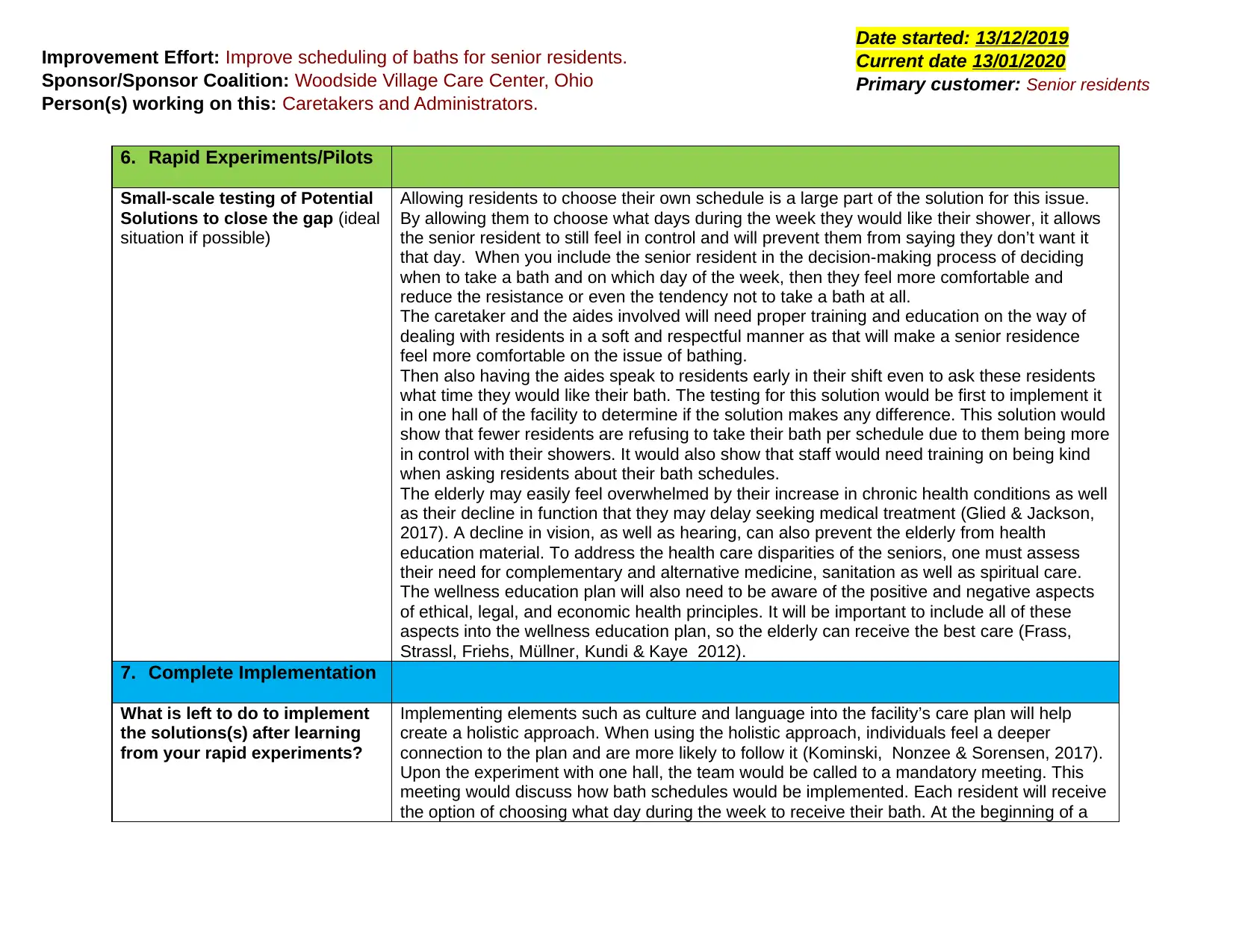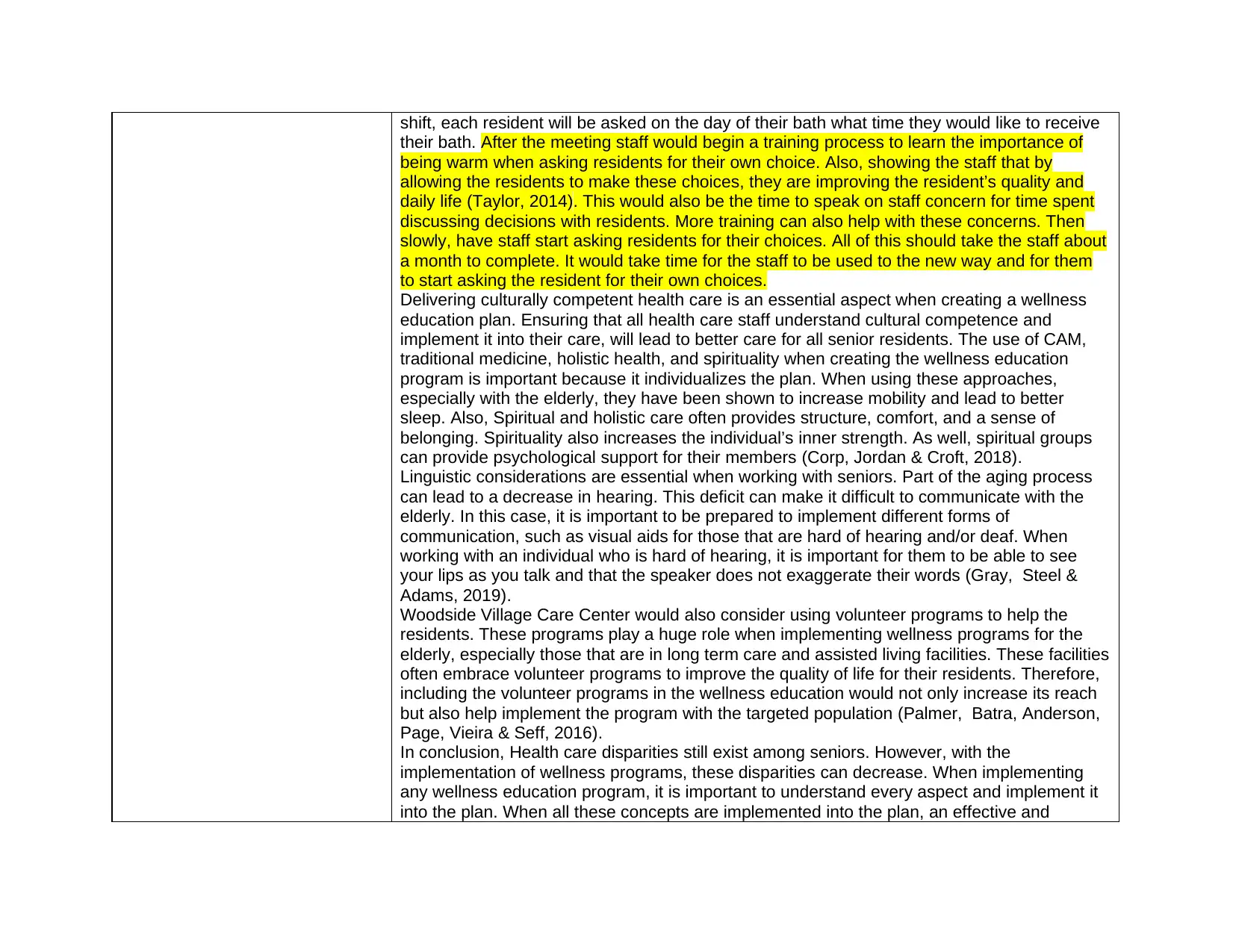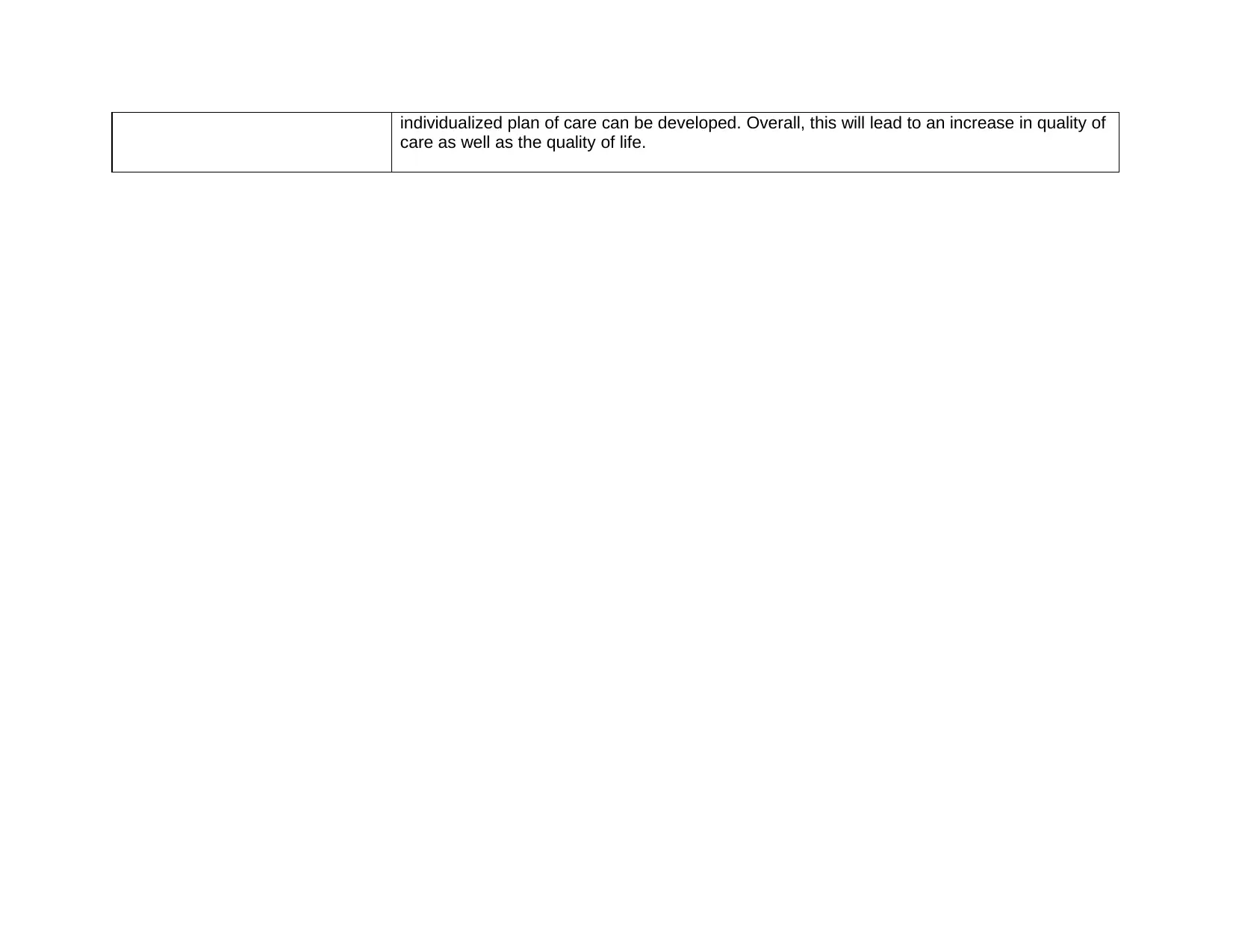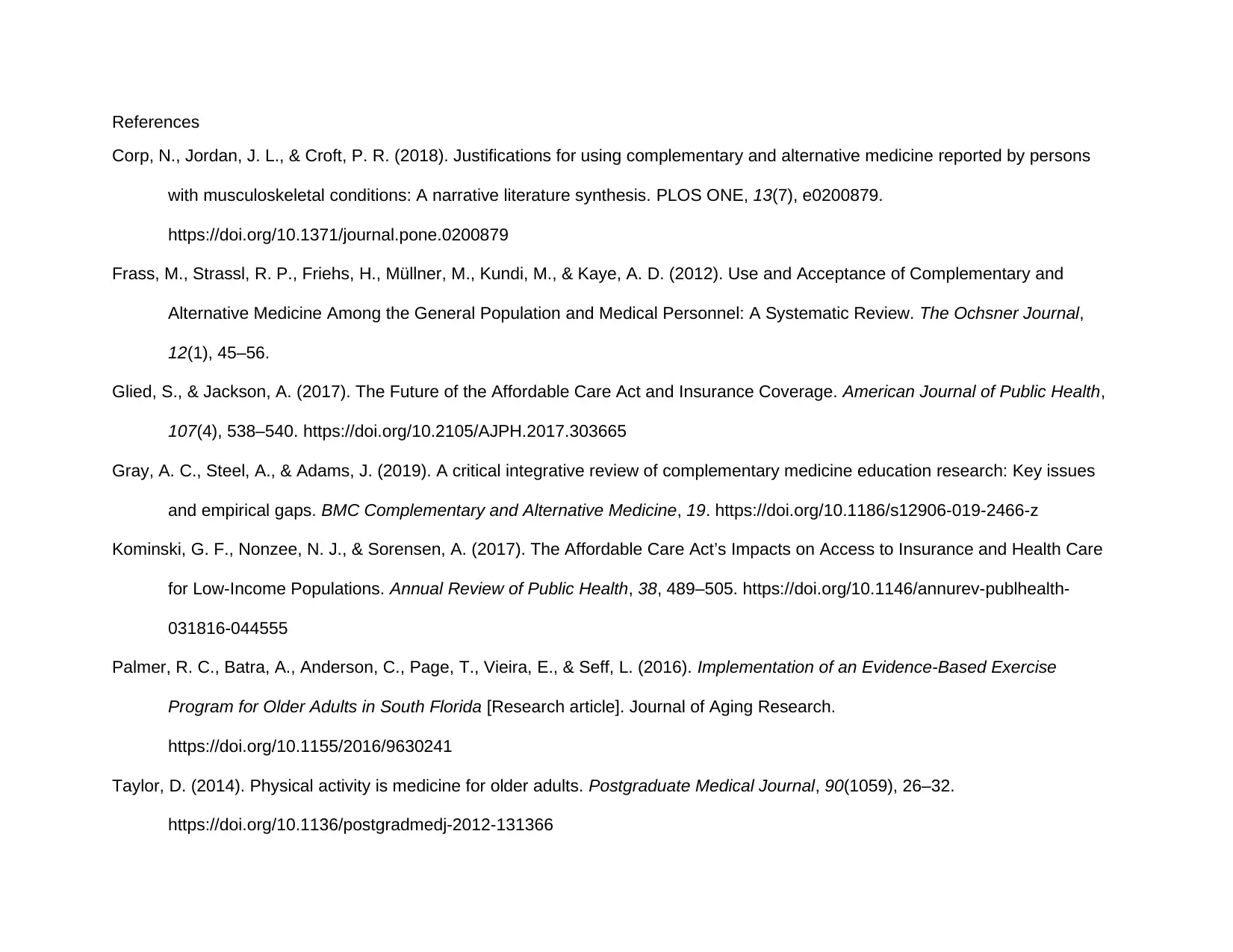Woodside Village: Improving Bathing Schedules for Senior Residents
VerifiedAdded on 2022/08/26
|5
|1547
|20
Report
AI Summary
This report details an improvement effort focused on enhancing the bath schedules for senior residents at Woodside Village Care Center. The primary goal is to increase resident satisfaction and reduce bath refusals by allowing residents to choose their preferred bath days and times. The solution involves staff training on respectful communication and incorporating residents' preferences into the care plan. The implementation strategy includes a pilot program on one hall, followed by a facility-wide rollout, with a strong emphasis on cultural competence, holistic care, and volunteer programs to address healthcare disparities. The report references several studies to support the proposed solutions, emphasizing the importance of individualized care plans, wellness education, and the inclusion of complementary and alternative medicine, sanitation, and spiritual care to improve the quality of life for senior residents. The report concludes that by implementing these strategies, healthcare disparities can be reduced, leading to better care and an improved quality of life for senior residents.

6. Rapid Experiments/Pilots
Small-scale testing of Potential
Solutions to close the gap (ideal
situation if possible)
Allowing residents to choose their own schedule is a large part of the solution for this issue.
By allowing them to choose what days during the week they would like their shower, it allows
the senior resident to still feel in control and will prevent them from saying they don’t want it
that day. When you include the senior resident in the decision-making process of deciding
when to take a bath and on which day of the week, then they feel more comfortable and
reduce the resistance or even the tendency not to take a bath at all.
The caretaker and the aides involved will need proper training and education on the way of
dealing with residents in a soft and respectful manner as that will make a senior residence
feel more comfortable on the issue of bathing.
Then also having the aides speak to residents early in their shift even to ask these residents
what time they would like their bath. The testing for this solution would be first to implement it
in one hall of the facility to determine if the solution makes any difference. This solution would
show that fewer residents are refusing to take their bath per schedule due to them being more
in control with their showers. It would also show that staff would need training on being kind
when asking residents about their bath schedules.
The elderly may easily feel overwhelmed by their increase in chronic health conditions as well
as their decline in function that they may delay seeking medical treatment (Glied & Jackson,
2017). A decline in vision, as well as hearing, can also prevent the elderly from health
education material. To address the health care disparities of the seniors, one must assess
their need for complementary and alternative medicine, sanitation as well as spiritual care.
The wellness education plan will also need to be aware of the positive and negative aspects
of ethical, legal, and economic health principles. It will be important to include all of these
aspects into the wellness education plan, so the elderly can receive the best care (Frass,
Strassl, Friehs, Müllner, Kundi & Kaye 2012).
7. Complete Implementation
What is left to do to implement
the solutions(s) after learning
from your rapid experiments?
Implementing elements such as culture and language into the facility’s care plan will help
create a holistic approach. When using the holistic approach, individuals feel a deeper
connection to the plan and are more likely to follow it (Kominski, Nonzee & Sorensen, 2017).
Upon the experiment with one hall, the team would be called to a mandatory meeting. This
meeting would discuss how bath schedules would be implemented. Each resident will receive
the option of choosing what day during the week to receive their bath. At the beginning of a
Improvement Effort: Improve scheduling of baths for senior residents.
Sponsor/Sponsor Coalition: Woodside Village Care Center, Ohio
Person(s) working on this: Caretakers and Administrators.
Date started: 13/12/2019
Current date 13/01/2020
Primary customer: Senior residents
Small-scale testing of Potential
Solutions to close the gap (ideal
situation if possible)
Allowing residents to choose their own schedule is a large part of the solution for this issue.
By allowing them to choose what days during the week they would like their shower, it allows
the senior resident to still feel in control and will prevent them from saying they don’t want it
that day. When you include the senior resident in the decision-making process of deciding
when to take a bath and on which day of the week, then they feel more comfortable and
reduce the resistance or even the tendency not to take a bath at all.
The caretaker and the aides involved will need proper training and education on the way of
dealing with residents in a soft and respectful manner as that will make a senior residence
feel more comfortable on the issue of bathing.
Then also having the aides speak to residents early in their shift even to ask these residents
what time they would like their bath. The testing for this solution would be first to implement it
in one hall of the facility to determine if the solution makes any difference. This solution would
show that fewer residents are refusing to take their bath per schedule due to them being more
in control with their showers. It would also show that staff would need training on being kind
when asking residents about their bath schedules.
The elderly may easily feel overwhelmed by their increase in chronic health conditions as well
as their decline in function that they may delay seeking medical treatment (Glied & Jackson,
2017). A decline in vision, as well as hearing, can also prevent the elderly from health
education material. To address the health care disparities of the seniors, one must assess
their need for complementary and alternative medicine, sanitation as well as spiritual care.
The wellness education plan will also need to be aware of the positive and negative aspects
of ethical, legal, and economic health principles. It will be important to include all of these
aspects into the wellness education plan, so the elderly can receive the best care (Frass,
Strassl, Friehs, Müllner, Kundi & Kaye 2012).
7. Complete Implementation
What is left to do to implement
the solutions(s) after learning
from your rapid experiments?
Implementing elements such as culture and language into the facility’s care plan will help
create a holistic approach. When using the holistic approach, individuals feel a deeper
connection to the plan and are more likely to follow it (Kominski, Nonzee & Sorensen, 2017).
Upon the experiment with one hall, the team would be called to a mandatory meeting. This
meeting would discuss how bath schedules would be implemented. Each resident will receive
the option of choosing what day during the week to receive their bath. At the beginning of a
Improvement Effort: Improve scheduling of baths for senior residents.
Sponsor/Sponsor Coalition: Woodside Village Care Center, Ohio
Person(s) working on this: Caretakers and Administrators.
Date started: 13/12/2019
Current date 13/01/2020
Primary customer: Senior residents
Paraphrase This Document
Need a fresh take? Get an instant paraphrase of this document with our AI Paraphraser

shift, each resident will be asked on the day of their bath what time they would like to receive
their bath. After the meeting staff would begin a training process to learn the importance of
being warm when asking residents for their own choice. Also, showing the staff that by
allowing the residents to make these choices, they are improving the resident’s quality and
daily life (Taylor, 2014). This would also be the time to speak on staff concern for time spent
discussing decisions with residents. More training can also help with these concerns. Then
slowly, have staff start asking residents for their choices. All of this should take the staff about
a month to complete. It would take time for the staff to be used to the new way and for them
to start asking the resident for their own choices.
Delivering culturally competent health care is an essential aspect when creating a wellness
education plan. Ensuring that all health care staff understand cultural competence and
implement it into their care, will lead to better care for all senior residents. The use of CAM,
traditional medicine, holistic health, and spirituality when creating the wellness education
program is important because it individualizes the plan. When using these approaches,
especially with the elderly, they have been shown to increase mobility and lead to better
sleep. Also, Spiritual and holistic care often provides structure, comfort, and a sense of
belonging. Spirituality also increases the individual’s inner strength. As well, spiritual groups
can provide psychological support for their members (Corp, Jordan & Croft, 2018).
Linguistic considerations are essential when working with seniors. Part of the aging process
can lead to a decrease in hearing. This deficit can make it difficult to communicate with the
elderly. In this case, it is important to be prepared to implement different forms of
communication, such as visual aids for those that are hard of hearing and/or deaf. When
working with an individual who is hard of hearing, it is important for them to be able to see
your lips as you talk and that the speaker does not exaggerate their words (Gray, Steel &
Adams, 2019).
Woodside Village Care Center would also consider using volunteer programs to help the
residents. These programs play a huge role when implementing wellness programs for the
elderly, especially those that are in long term care and assisted living facilities. These facilities
often embrace volunteer programs to improve the quality of life for their residents. Therefore,
including the volunteer programs in the wellness education would not only increase its reach
but also help implement the program with the targeted population (Palmer, Batra, Anderson,
Page, Vieira & Seff, 2016).
In conclusion, Health care disparities still exist among seniors. However, with the
implementation of wellness programs, these disparities can decrease. When implementing
any wellness education program, it is important to understand every aspect and implement it
into the plan. When all these concepts are implemented into the plan, an effective and
their bath. After the meeting staff would begin a training process to learn the importance of
being warm when asking residents for their own choice. Also, showing the staff that by
allowing the residents to make these choices, they are improving the resident’s quality and
daily life (Taylor, 2014). This would also be the time to speak on staff concern for time spent
discussing decisions with residents. More training can also help with these concerns. Then
slowly, have staff start asking residents for their choices. All of this should take the staff about
a month to complete. It would take time for the staff to be used to the new way and for them
to start asking the resident for their own choices.
Delivering culturally competent health care is an essential aspect when creating a wellness
education plan. Ensuring that all health care staff understand cultural competence and
implement it into their care, will lead to better care for all senior residents. The use of CAM,
traditional medicine, holistic health, and spirituality when creating the wellness education
program is important because it individualizes the plan. When using these approaches,
especially with the elderly, they have been shown to increase mobility and lead to better
sleep. Also, Spiritual and holistic care often provides structure, comfort, and a sense of
belonging. Spirituality also increases the individual’s inner strength. As well, spiritual groups
can provide psychological support for their members (Corp, Jordan & Croft, 2018).
Linguistic considerations are essential when working with seniors. Part of the aging process
can lead to a decrease in hearing. This deficit can make it difficult to communicate with the
elderly. In this case, it is important to be prepared to implement different forms of
communication, such as visual aids for those that are hard of hearing and/or deaf. When
working with an individual who is hard of hearing, it is important for them to be able to see
your lips as you talk and that the speaker does not exaggerate their words (Gray, Steel &
Adams, 2019).
Woodside Village Care Center would also consider using volunteer programs to help the
residents. These programs play a huge role when implementing wellness programs for the
elderly, especially those that are in long term care and assisted living facilities. These facilities
often embrace volunteer programs to improve the quality of life for their residents. Therefore,
including the volunteer programs in the wellness education would not only increase its reach
but also help implement the program with the targeted population (Palmer, Batra, Anderson,
Page, Vieira & Seff, 2016).
In conclusion, Health care disparities still exist among seniors. However, with the
implementation of wellness programs, these disparities can decrease. When implementing
any wellness education program, it is important to understand every aspect and implement it
into the plan. When all these concepts are implemented into the plan, an effective and

individualized plan of care can be developed. Overall, this will lead to an increase in quality of
care as well as the quality of life.
care as well as the quality of life.
⊘ This is a preview!⊘
Do you want full access?
Subscribe today to unlock all pages.

Trusted by 1+ million students worldwide

References
Corp, N., Jordan, J. L., & Croft, P. R. (2018). Justifications for using complementary and alternative medicine reported by persons
with musculoskeletal conditions: A narrative literature synthesis. PLOS ONE, 13(7), e0200879.
https://doi.org/10.1371/journal.pone.0200879
Frass, M., Strassl, R. P., Friehs, H., Müllner, M., Kundi, M., & Kaye, A. D. (2012). Use and Acceptance of Complementary and
Alternative Medicine Among the General Population and Medical Personnel: A Systematic Review. The Ochsner Journal,
12(1), 45–56.
Glied, S., & Jackson, A. (2017). The Future of the Affordable Care Act and Insurance Coverage. American Journal of Public Health,
107(4), 538–540. https://doi.org/10.2105/AJPH.2017.303665
Gray, A. C., Steel, A., & Adams, J. (2019). A critical integrative review of complementary medicine education research: Key issues
and empirical gaps. BMC Complementary and Alternative Medicine, 19. https://doi.org/10.1186/s12906-019-2466-z
Kominski, G. F., Nonzee, N. J., & Sorensen, A. (2017). The Affordable Care Act’s Impacts on Access to Insurance and Health Care
for Low-Income Populations. Annual Review of Public Health, 38, 489–505. https://doi.org/10.1146/annurev-publhealth-
031816-044555
Palmer, R. C., Batra, A., Anderson, C., Page, T., Vieira, E., & Seff, L. (2016). Implementation of an Evidence-Based Exercise
Program for Older Adults in South Florida [Research article]. Journal of Aging Research.
https://doi.org/10.1155/2016/9630241
Taylor, D. (2014). Physical activity is medicine for older adults. Postgraduate Medical Journal, 90(1059), 26–32.
https://doi.org/10.1136/postgradmedj-2012-131366
Corp, N., Jordan, J. L., & Croft, P. R. (2018). Justifications for using complementary and alternative medicine reported by persons
with musculoskeletal conditions: A narrative literature synthesis. PLOS ONE, 13(7), e0200879.
https://doi.org/10.1371/journal.pone.0200879
Frass, M., Strassl, R. P., Friehs, H., Müllner, M., Kundi, M., & Kaye, A. D. (2012). Use and Acceptance of Complementary and
Alternative Medicine Among the General Population and Medical Personnel: A Systematic Review. The Ochsner Journal,
12(1), 45–56.
Glied, S., & Jackson, A. (2017). The Future of the Affordable Care Act and Insurance Coverage. American Journal of Public Health,
107(4), 538–540. https://doi.org/10.2105/AJPH.2017.303665
Gray, A. C., Steel, A., & Adams, J. (2019). A critical integrative review of complementary medicine education research: Key issues
and empirical gaps. BMC Complementary and Alternative Medicine, 19. https://doi.org/10.1186/s12906-019-2466-z
Kominski, G. F., Nonzee, N. J., & Sorensen, A. (2017). The Affordable Care Act’s Impacts on Access to Insurance and Health Care
for Low-Income Populations. Annual Review of Public Health, 38, 489–505. https://doi.org/10.1146/annurev-publhealth-
031816-044555
Palmer, R. C., Batra, A., Anderson, C., Page, T., Vieira, E., & Seff, L. (2016). Implementation of an Evidence-Based Exercise
Program for Older Adults in South Florida [Research article]. Journal of Aging Research.
https://doi.org/10.1155/2016/9630241
Taylor, D. (2014). Physical activity is medicine for older adults. Postgraduate Medical Journal, 90(1059), 26–32.
https://doi.org/10.1136/postgradmedj-2012-131366
Paraphrase This Document
Need a fresh take? Get an instant paraphrase of this document with our AI Paraphraser

1 out of 5
Your All-in-One AI-Powered Toolkit for Academic Success.
+13062052269
info@desklib.com
Available 24*7 on WhatsApp / Email
![[object Object]](/_next/static/media/star-bottom.7253800d.svg)
Unlock your academic potential
Copyright © 2020–2025 A2Z Services. All Rights Reserved. Developed and managed by ZUCOL.
